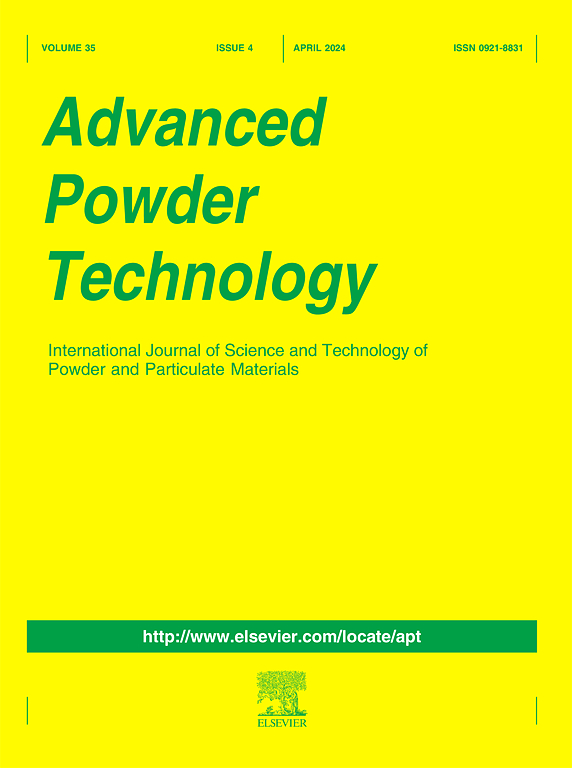合理构建具有快速界面电荷转移的BiVO4/CoNiFe-LDH S-scheme异质结用于四环素的高效光降解
IF 4.2
2区 工程技术
Q2 ENGINEERING, CHEMICAL
引用次数: 0
摘要
有效地开发具有快速界面电荷转移的s型异质结对抗生素的根除具有重要意义。本文通过将BiVO4微棒紧密锚定在CoNiFe-LDH微花表面,设计并构建了新型BiVO4/CoNiFe-LDH S-scheme异质结,并通过可见光照射下对四环素的降解性能进行了评价。不出所料,最佳BiVO4/CoNiFe-LDH异质结去除四环素的最大表观速率常数高达0.0120 min−1,比单独的CoNiFe-LDH (0.0012 min−1)和BiVO4 (0.0061 min−1)分别快约10.0和2.0倍。由于在CoNiFe-LDH和BiVO4之间的界面处形成了S-scheme异质结,大大加快了电荷分离,并在建立的内部电场的作用下保持了强大的氧化还原能力,从而显著提高了光降解活性。此外,活性物种证实试验证实了•O2 -和h+对四环素的降解有很大贡献。最后,对四环素可能的降解途径和机理进行了阐述。本研究为制备具有快速界面电荷迁移的高效s型异质结去除抗生素提供了新的见解和视角。本文章由计算机程序翻译,如有差异,请以英文原文为准。

Reasonably constructing BiVO4/CoNiFe-LDH S-scheme heterojunction with fast interface charge transfer for efficient photodegradation of tetracycline
Developing efficaciously S-scheme heterojunction with fast interface charge transfer is of significant importance for antibiotics eradication. Herein, an innovative BiVO4/CoNiFe-LDH S-scheme heterojunction was strategically designed and constructed by tightly anchoring BiVO4 microrods onto the surfaces of CoNiFe-LDH microflowers, and its degradation performance was assessed via eradicating tetracycline under visible light irradiation. Unsurprisingly, the optimal BiVO4/CoNiFe-LDH heterojunction acquired the maximum apparent rate constant of up to 0.0120 min−1 for tetracycline removal, which was approximately 10.0 and 2.0 times more fast than those of sole CoNiFe-LDH (0.0012 min−1) and BiVO4 (0.0061 min−1), separately. The significantly boosted photodegradation activity was benefited from the creation of S-scheme heterojunction at the interface between CoNiFe-LDH and BiVO4, considerably expediting the charge separation and maintaining the powerful redox capacity under the force of established internal electric field. Furthermore, reactive species substantiation tests corroborated that •O2– and h+ were greatly contributed to tetracycline degradation. In the end, the possible degradation pathways and mechanism of tetracycline were also elucidated. This work affords new insights and perspectives on the fabrication of high-efficiency S-scheme heterojunction with fast interface charge migration for antibiotic removal.
求助全文
通过发布文献求助,成功后即可免费获取论文全文。
去求助
来源期刊

Advanced Powder Technology
工程技术-工程:化工
CiteScore
9.50
自引率
7.70%
发文量
424
审稿时长
55 days
期刊介绍:
The aim of Advanced Powder Technology is to meet the demand for an international journal that integrates all aspects of science and technology research on powder and particulate materials. The journal fulfills this purpose by publishing original research papers, rapid communications, reviews, and translated articles by prominent researchers worldwide.
The editorial work of Advanced Powder Technology, which was founded as the International Journal of the Society of Powder Technology, Japan, is now shared by distinguished board members, who operate in a unique framework designed to respond to the increasing global demand for articles on not only powder and particles, but also on various materials produced from them.
Advanced Powder Technology covers various areas, but a discussion of powder and particles is required in articles. Topics include: Production of powder and particulate materials in gases and liquids(nanoparticles, fine ceramics, pharmaceuticals, novel functional materials, etc.); Aerosol and colloidal processing; Powder and particle characterization; Dynamics and phenomena; Calculation and simulation (CFD, DEM, Monte Carlo method, population balance, etc.); Measurement and control of powder processes; Particle modification; Comminution; Powder handling and operations (storage, transport, granulation, separation, fluidization, etc.)
 求助内容:
求助内容: 应助结果提醒方式:
应助结果提醒方式:


